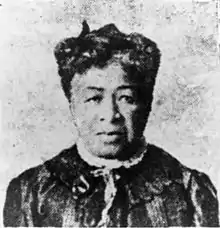Lucy Stanton (abolitionist)
Lucy Stanton Day Sessions (October 16, 1831 – February 18, 1910) was an American abolitionist and feminist[1] figure, notable for being the first African-American woman to complete a four-year course of a study at a college or university.[2][3] She completed a Ladies Literary Course from Oberlin College in 1850.[4]
Lucy Stanton | |
|---|---|
 Stanton c. 1910 | |
| Born | October 16, 1831 Ohio, US |
| Died | February 18, 1910 (aged 78) Los Angeles, California, US |
| Burial place | Angelus-Rosedale Cemetery, Los Angeles |
| Occupation | Abolitionist |
| Known for | Being the first African-American woman to complete a four-year course of study at a college or university |
| Spouses |
|
Day's life was a testament to the many strong, resilient, and radical women that participated in the first wave of American feminism. Her passionate commitment to abolition especially connected her to her radical female predecessors, such as Angelina E. Grimké, who, as early as 1836, linked the abolition of slavery to the Christian duty of women.[1]
Early life
Lucy Stanton was born free, the only child of Margaret and Samuel Stanton, on October 16, 1831.[4] When her biological father Samuel, a barber, died when she was only 18 months old, Stanton's mother married John Brown, an abolitionist famous around Cleveland, Ohio, for his participation in the Underground Railroad. Stanton is noted as saying that John Brown would harbor as many as 13 runaway slaves in their house at any given time.[3][5]
Education
In addition to his work as an abolitionist, John Brown was also an advocate for African-American education. Stanton attended the Cleveland Free School that Brown formed for African-American children.[3]
In 1846, Stanton enrolled in Oberlin College, completing a Literary degree in the "Ladies' Literary Course" of study in 1849.[6] This degree differed from the B.A. offered to men in that it did not require foreign languages or higher mathematics.[7] At Oberlin College, Stanton was very active in the Ladies' Literary Society and was invited (and presented) a speech at her graduation entitled "A Plea for the Oppressed" which expressed her abolitionist sentiments.[7] This speech, in response to the Fugitive Slave Act of 1850 which was about to take effect, urged the audience, particularly women, to put themselves in the place of the enslaved, to join the abolitionist cause, and to ultimately end slavery in the United States.[7] Her speech was immensely well-received, and reprinted in publications like The Oberlin Evangelist, the Oberlin College school newspaper, and "The Condition, Elevation, Emigration, and Destiny of the Colored People of the United States Politically Considered".[3]
Personal life and activism
Fresh out of school, Lucy Stanton began working as a principal at another free school in Cleveland. On November 25, 1852, Stanton married William H. Day, also an Oberlin College graduate. Stanton worked as a librarian and assisted her husband as editor for the first of Cleveland's African-American newspapers, The Aliened American. In the first issue dated, April 9, 1853, Stanton became the first African-American woman to publish a work of fiction entitled "Charles and Clara Hays.[8] She was a member of the Chatham Vigilance Committee which was organized to prevent people from being sold or returned to slavery.[9][10]
Stanton and Day had a daughter, Florence Day, born in 1858. Shortly after her birth, Day abandoned his wife and child, leaving for England. Stanton successfully received a divorce from Day in 1872.[2] Following Day's abandonment, Stanton worked as a seamstress in Cleveland while continuing her activism. Her affiliation with the Cleveland Freedmen's Aid Society led to her being sent first to Georgia in 1866 and then to Mississippi, both to teach newly freed slaves. While in Mississippi, Stanton met, and then in 1878 married, Levi Sessions. The couple moved to Tennessee where Stanton continued to be a supporter of women's and African Americans' rights by working with organizations such as the Women's Relief Corps, the Order of Eastern Star, the Women's Christian Temperance Union, and the African Methodist Episcopal Church.[3]
After the death of her mother in 1900, Stanton moved to Los Angeles. In 1904, with the assistance of black church and club women, she established the Sojourner Truth Industrial Club as a "safe refuge" for the hundreds of black working women migrating to the city.[11] The club sought to promote the guidance and development of young African-American women. [12] Stanton died in Los Angeles, California, on February 18, 1910 at the age of 78 and was buried in Angelus-Rosedale Cemetery.[13]
References
- Hoak, Lisa; Quigley, Dan; Weiss-Tisman, Essie. "Lucy Stanton Day". Oberlin College Archives. Oberlin College Library. Retrieved November 18, 2014.
- Encyclopedia of Cleveland History.
- Lawson-Merrill Papers 1978–1983, compiled by Ellen Nickenzie Lawson and Marlene Deahl Merrill, Oberlin College Archives.
- Garner, Carla (November 8, 2010). "Sessions, Lucy Stanton Day (1831–1910)". BlackPast.org. Retrieved December 10, 2014.
- Smith, Jessie Carney (ed.), Notable Black American Women, Vol. 2, Gale Research, 1992.
- "Oberlin College Minority Student Records".
- Foner, Philip S., and Robert James Branham (eds), Lift Every Voice: African American Oratory 1787–1900, University of Alabama Press, 1998.
- "The Aliened American". April 9, 1853.
- "Reframing Resistance: 1858". Huron Research. November 30, 2017. Retrieved April 11, 2021.
- "Lucy Stanton Day". www.huronantislaveryhistory.ca. Retrieved April 11, 2021.
- Taylor, Quintard; Moore, Shirley Ann Wilson, eds. (2003). African American Women Confront the West 1600–2000. Norman, OK: University of Oklahoma Press. p. 12. ISBN 9780806135243.
- Starr, Kevin (1997). The Dream Endures: California Enters the 1940s. New York, NY: Oxford University Press. p. 177. ISBN 0195100794.
- "Los Angeles herald. (Los Angeles [Calif.]) 1900-1911, February 20, 1910, Image 6". Los Angeles Herald. February 20, 1910. p. 6. ISSN 1941-2975. Retrieved February 5, 2019.